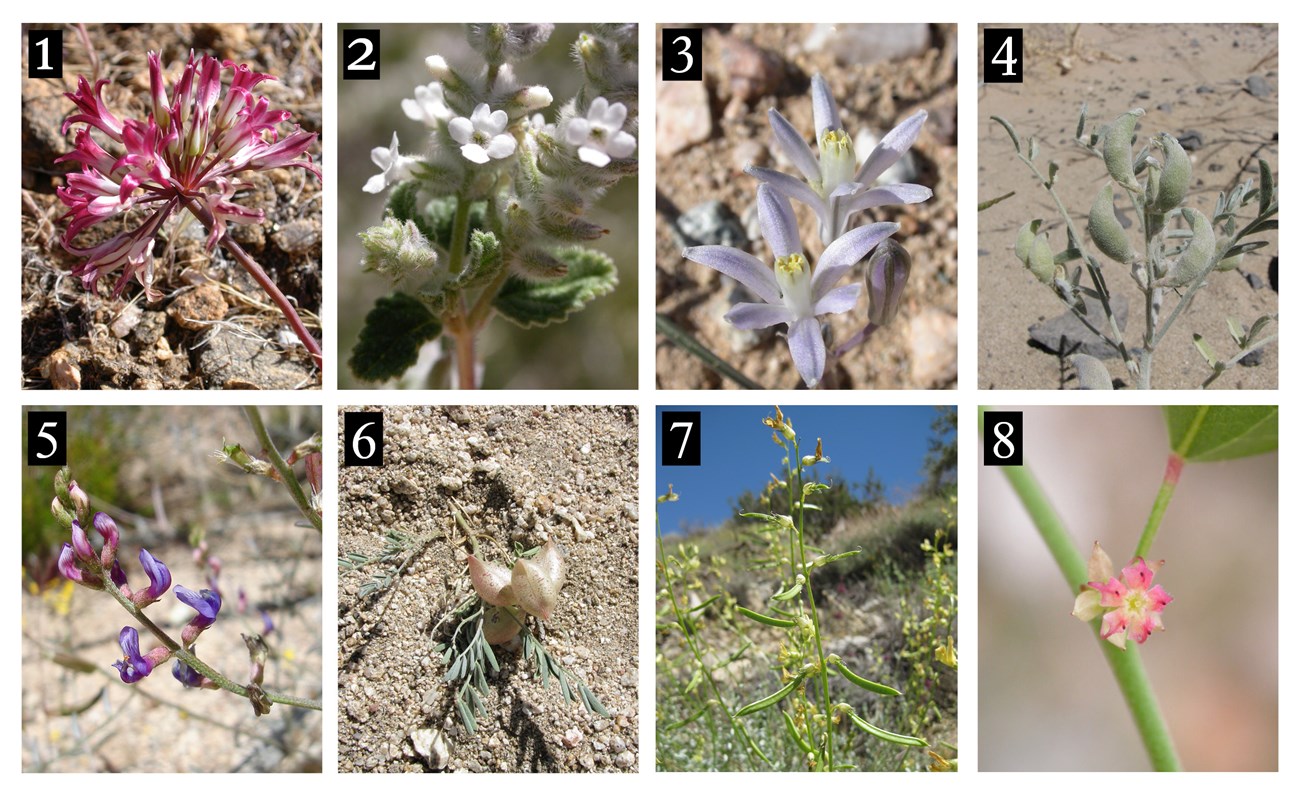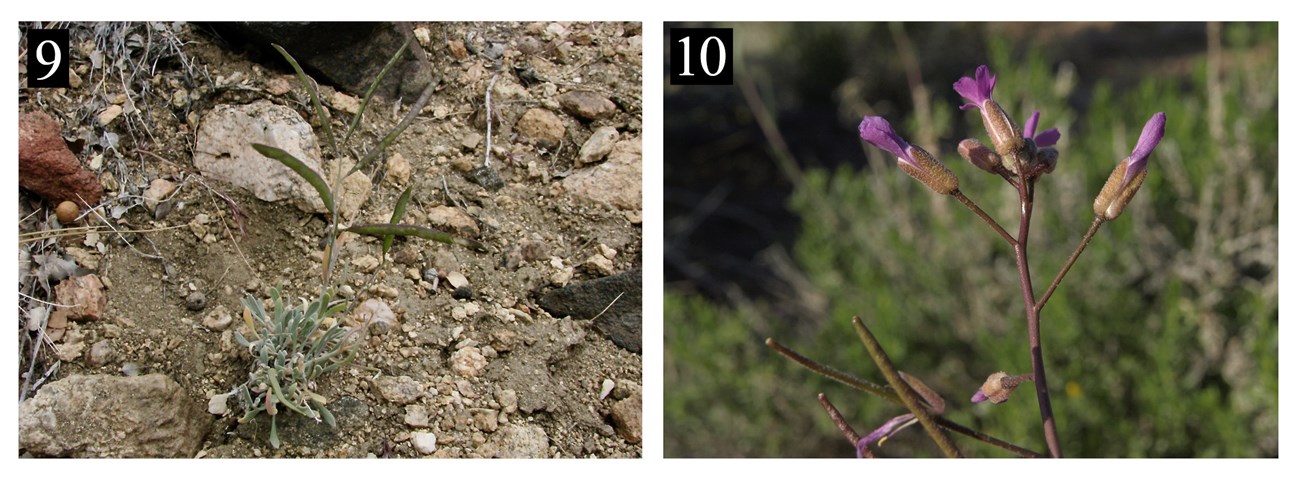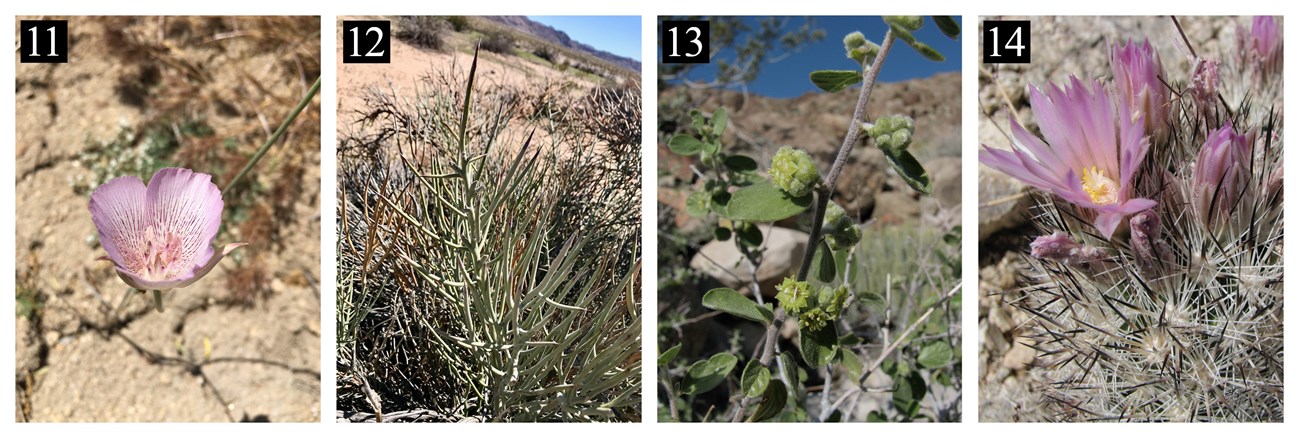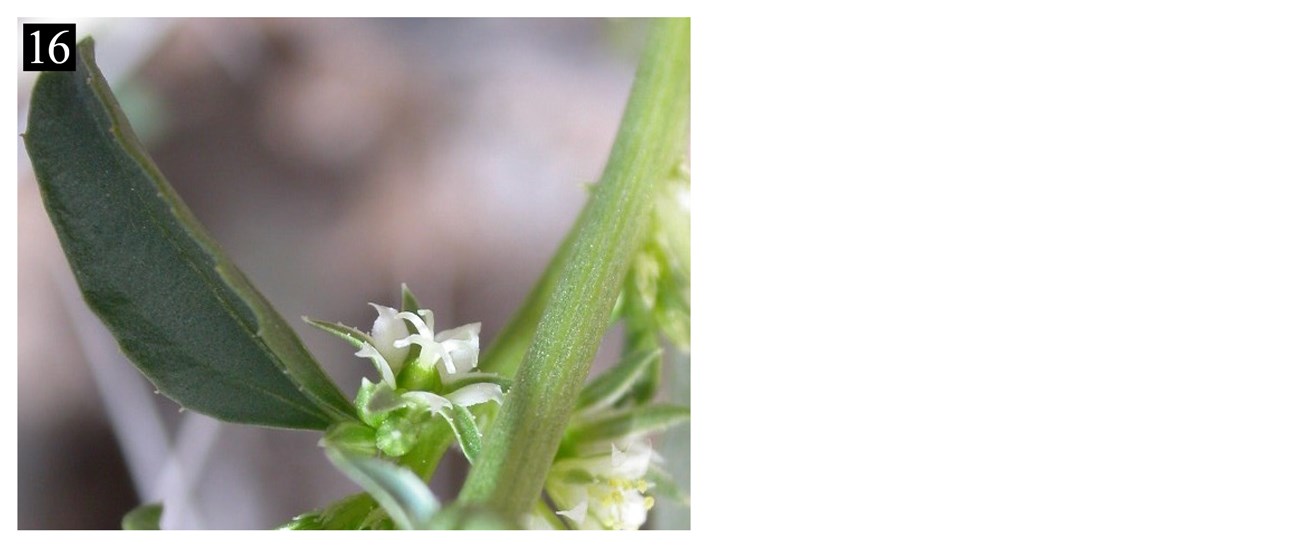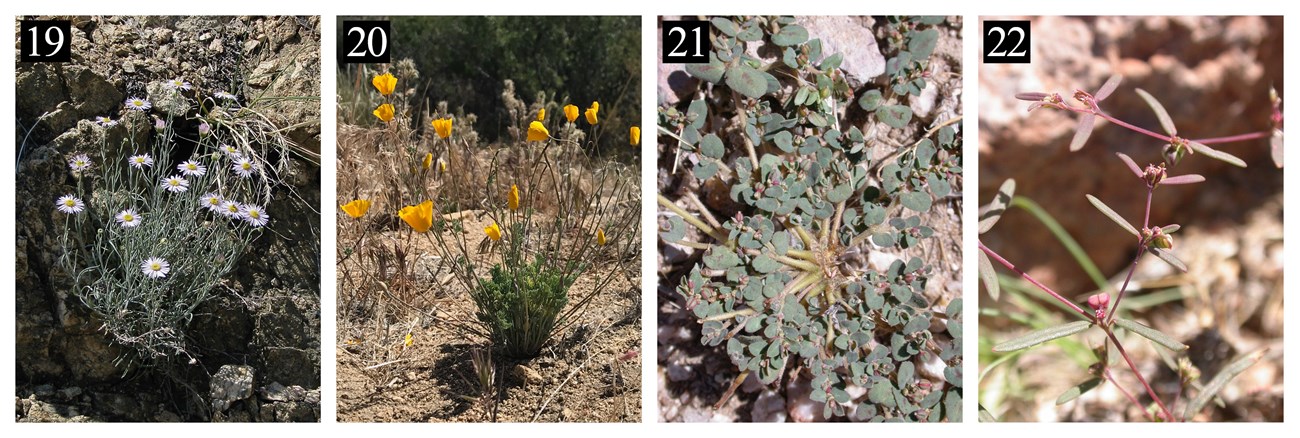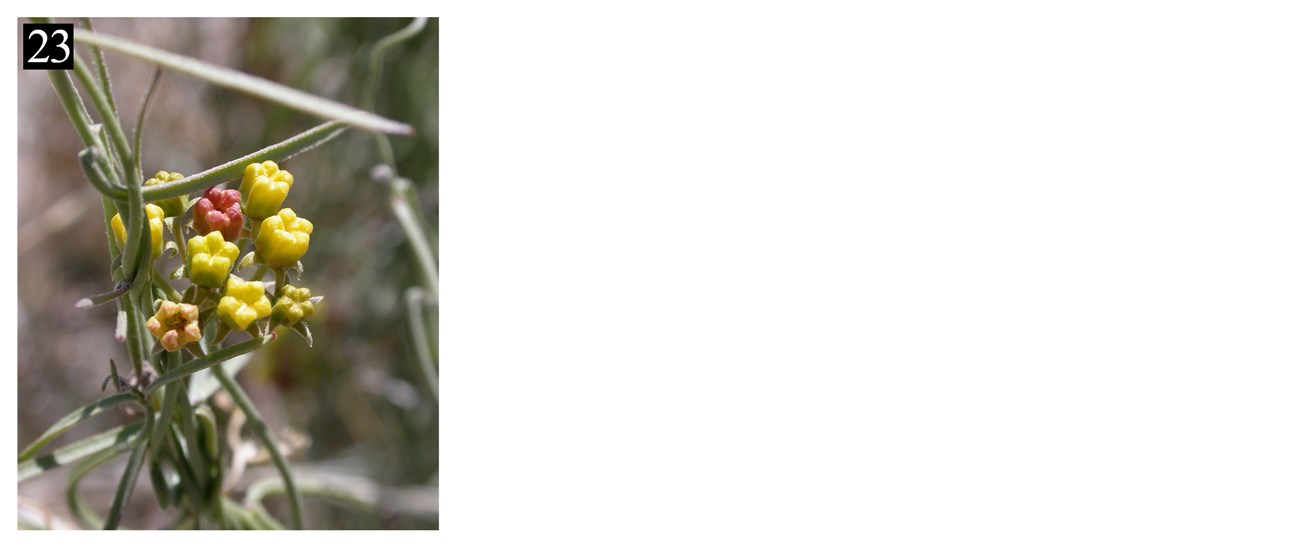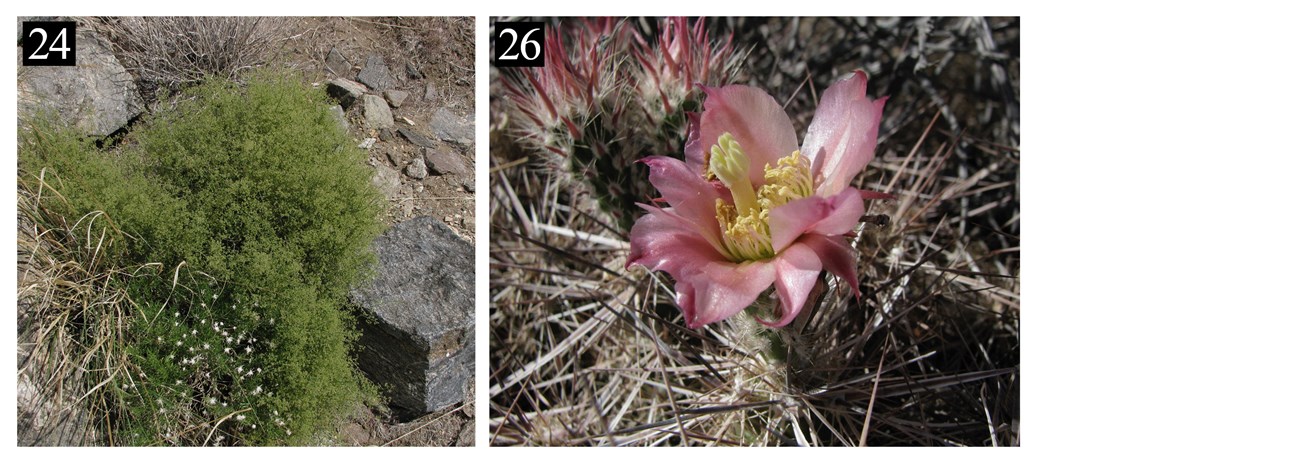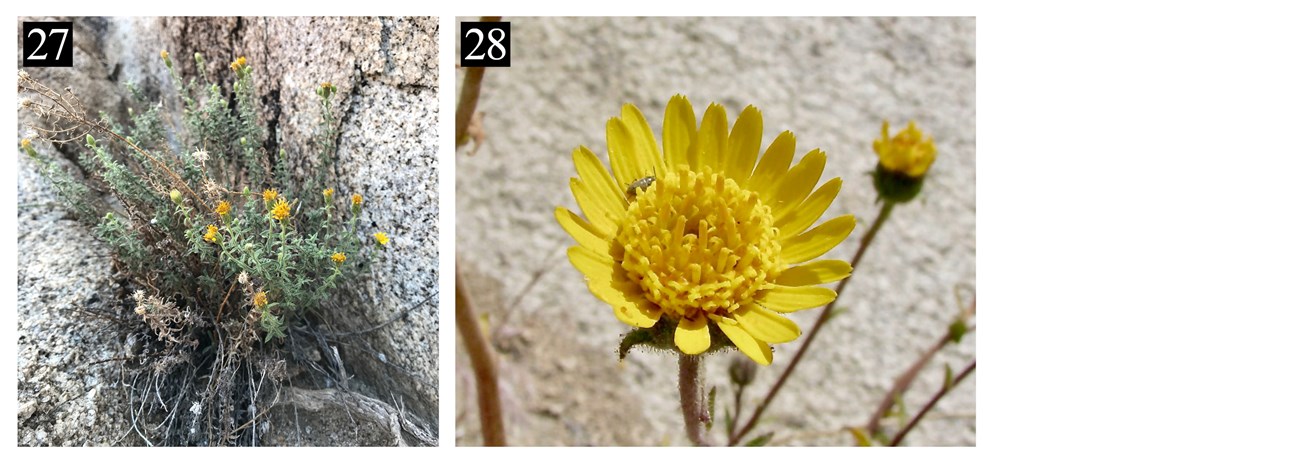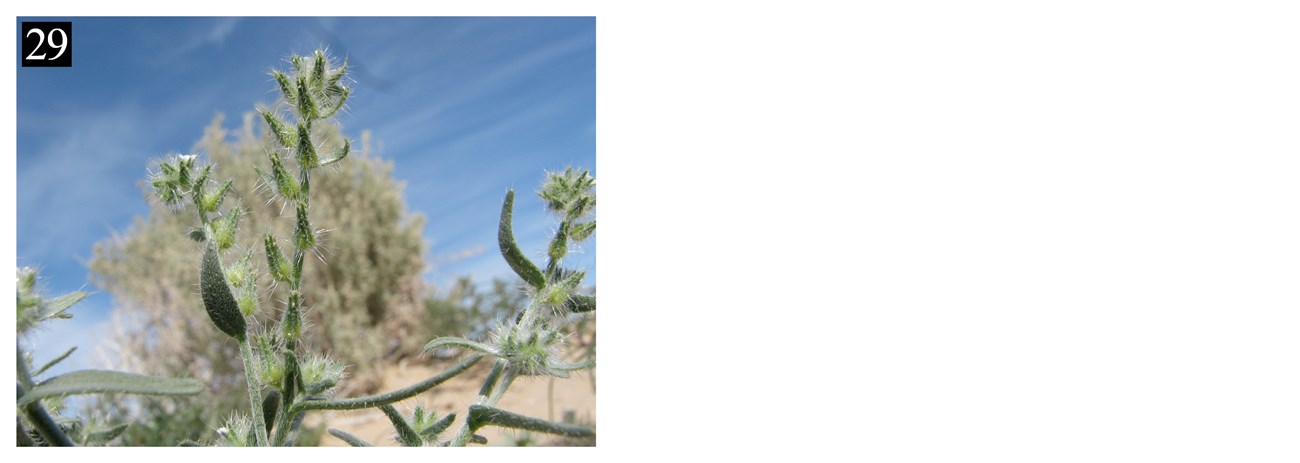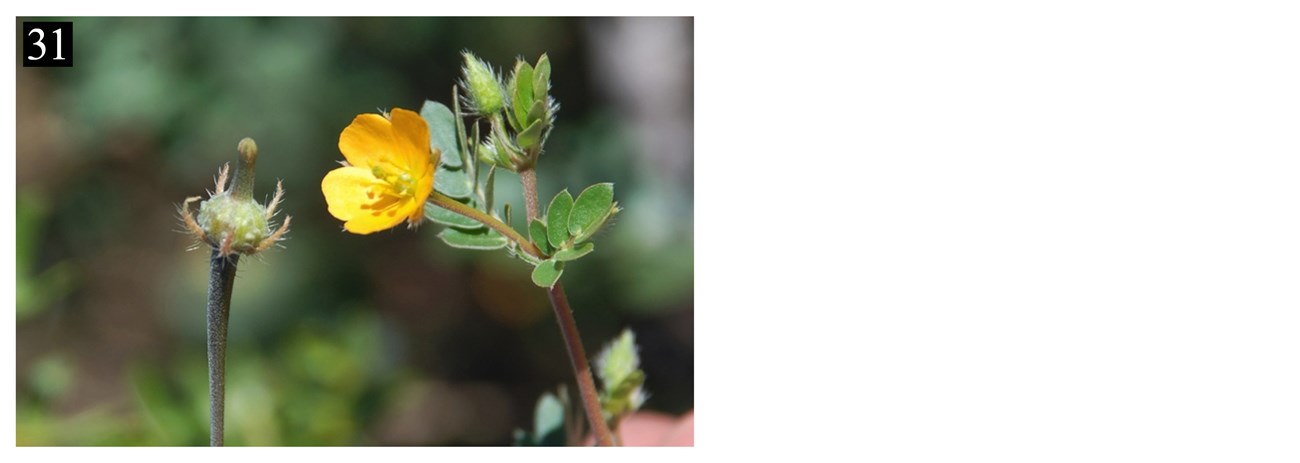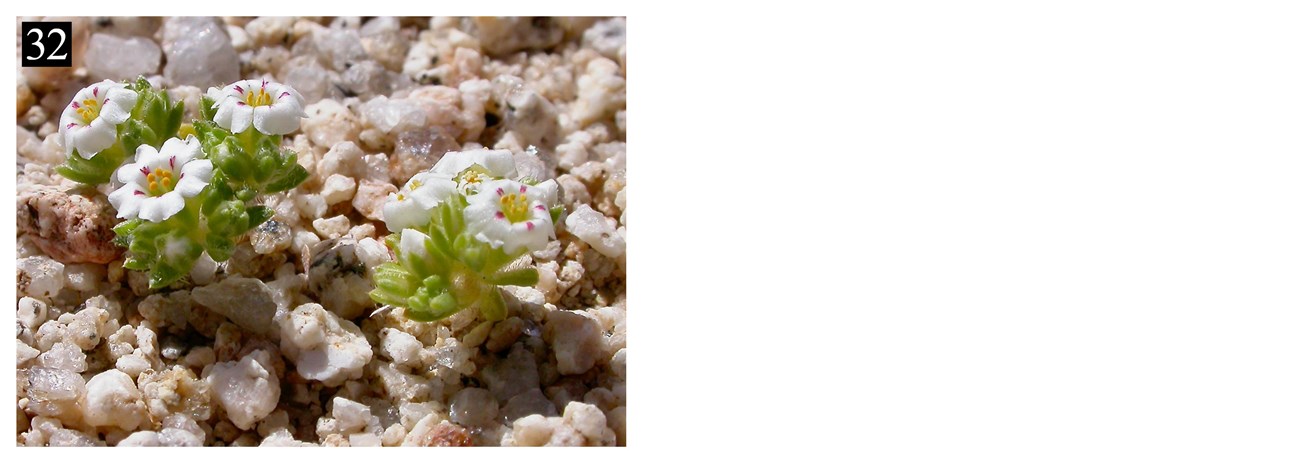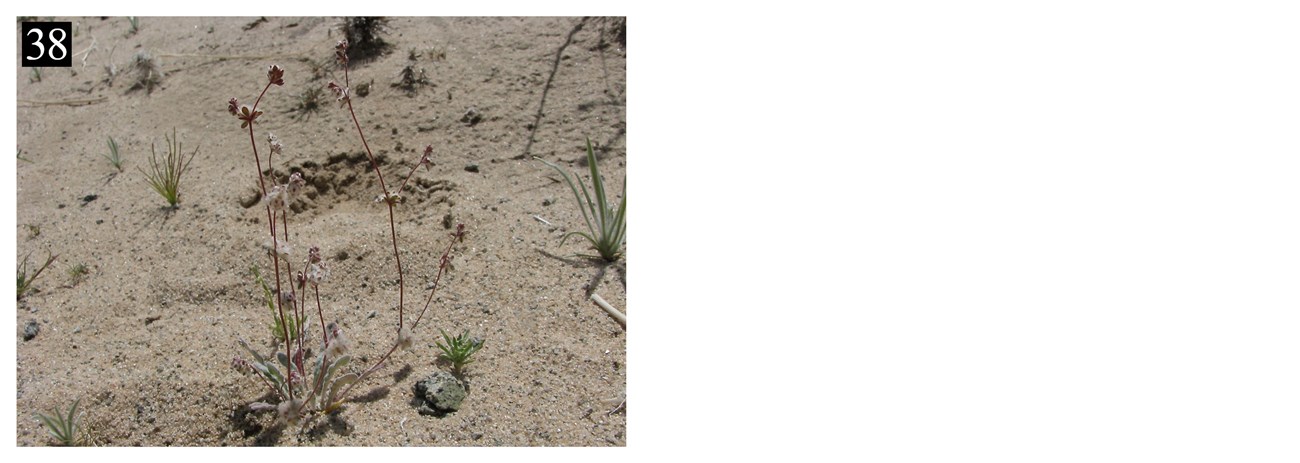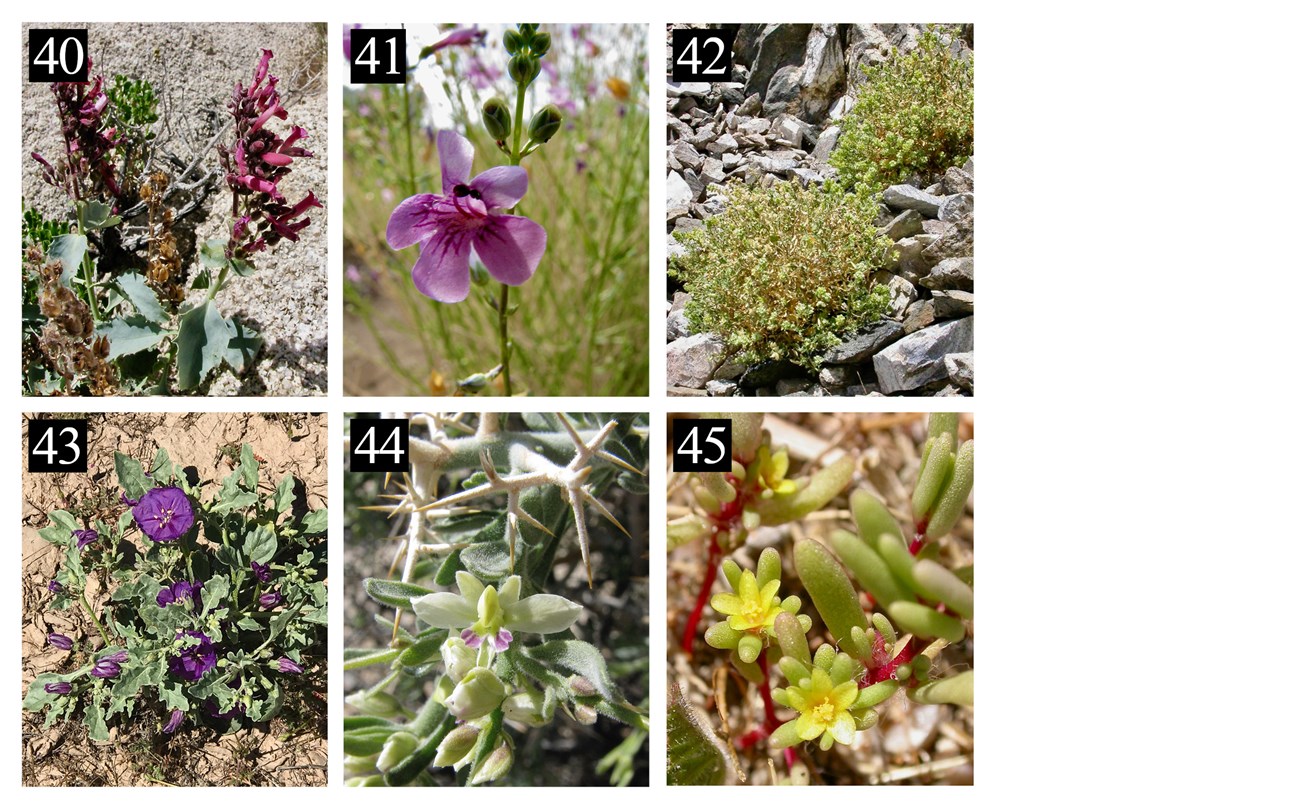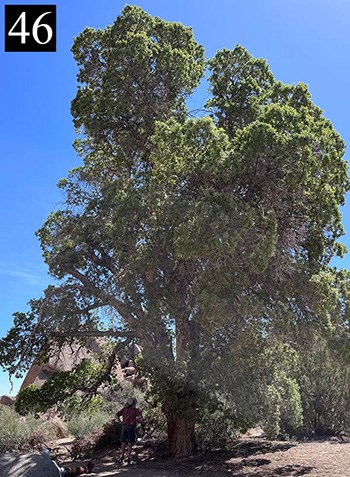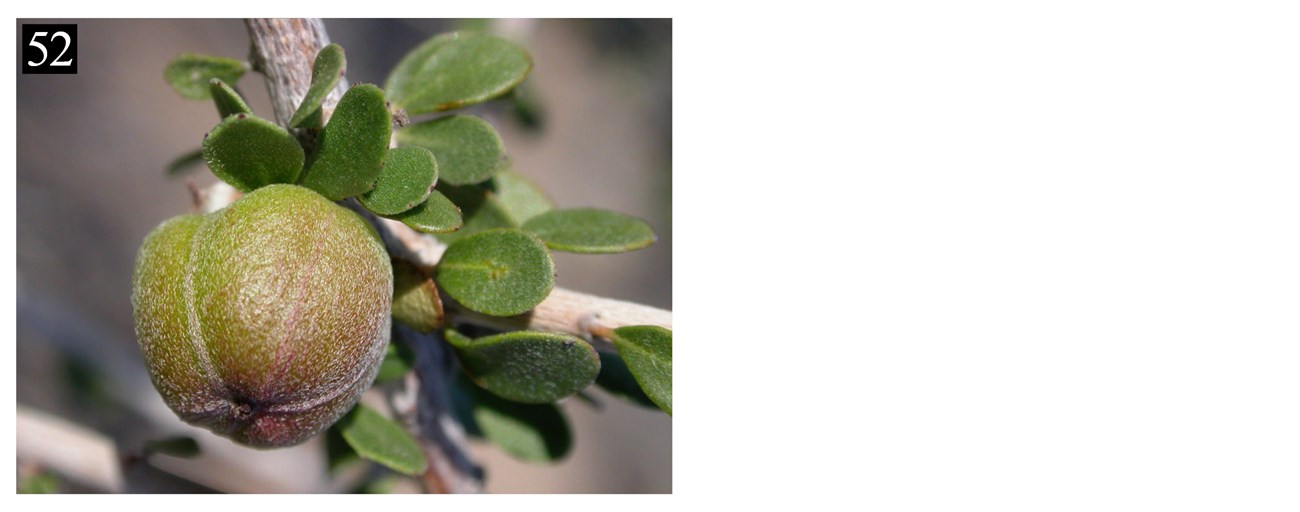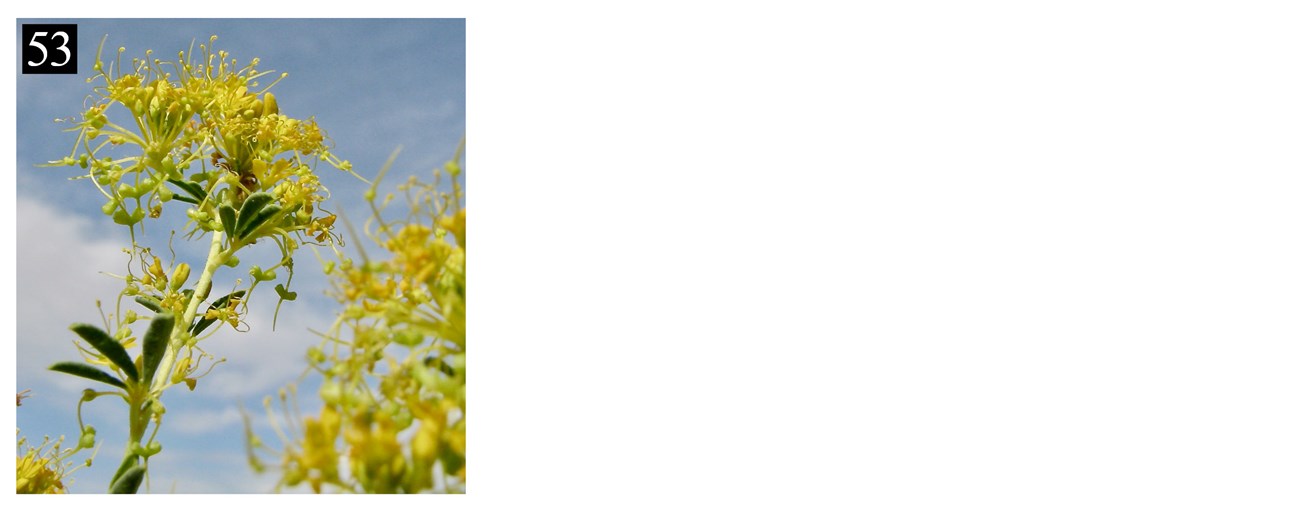Joshua Tree National Park (JTNP) provides habitat protection for 54 rare plant species, including two federally listed species, three on the Joshua Tree Watchlist, and 49 listed on the California Native Plant Society. Most of these rare plants are threatened beyond our boundaries by mining, off-road vehicle use, industrial-scale solar development, and increasing urbanization throughout San Bernardino and Riverside counties.
Nomenclatural, ecological, and distributional information is obtained and updated based on the taxon and generally cited from Jepson Herbarium eFlora, Flora of North America, and other appropriate taxonomic treatments. Rarity status information is based on California Native Plant Society (CNPS) and California Department of Fish and Wildlife California Rare Plant Rank (CRPR), found in California’s Natural Diversity Database or the CNPS Rare Plant Inventory. Rarity definitions can be found in the CNPS Inventory Glossary. All taxa with a CRPR of 1, 2, 3, and some 4 meet the definition of endangered, rare, or threatened under California Environmental Quality Act, Section 15380, and must be evaluated during environmental review.
1. Allium parishii
Rarity: CRPR 4.3, S3/G3
Family: Alliaceae
Common Name: Parish’s onion
This member of the Alliaceae family is limited to dispersed populations ranging from the San Bernardino Mountains in California to the mountains along the western edge of Arizona. Parish’s onion is a bulbiferous perennial found on open, rocky slopes in Joshua tree woodlands, pinyon-juniper woodlands, and Mojave Desert scrubs. In Joshua Tree National Park, it is most often found above 1000 m in gravelly, open ridgetops and rocky slopes scattered throughout the Little San Bernardino Mountains. The single scape produces 6-15 bright pink flowers in an umbel. The pedicels can be short and stout, meaning that some of them are shorter than the length of the tepals. Parish’s onion blooms from April to early June and occurs at elevations ranging between 850-1600 m. Allium parishii has 6-15 flowers, 12-18 mm tepals, and thick pedicels <12 mm long. It produces one narrow (1-3 mm) leaf that is round and solid in cross-section. This species is most threatened by mining and vehicles throughout its range.
2. Aloysia wrightii
Rarity: CRPR 4.3, S4/G5
Family: Verbenaceae
Common Name: Oreganillo, Wright’s beebrush
Oreganillo is a perennial evergreen shrub with a distinctive oregano smell, hence its common name. It is fairly widespread in the Desert Southwest, occurring in Arizona, Nevada, New Mexico, Texas, Utah, Baja California, and Sonora, Mexico. In California, it is restricted to a few mountain ranges in Riverside and San Bernardino counties. Aloysia wrightii grows in rocky, often carbonate soils in Joshua tree and pinyon-juniper woodlands. In JTNP, which represents the western most portion of its distribution, it is often associated with bouldery, narrow drainages on rocky slopes. The tomentose leaves and stems give the herbage a gray-green appearance, and the opposite leaves have crenate margins with strongly impressed veins on the top surface. Look for its densely hairy panicles with small white flowers during September and October. In the park, Aloysia wrightii can be found at elevations between 750-1400 m in the Eagle, Pinto, and Hexie Mtns, and it barely reaches the eastern slopes of Queen Mountain.
3. Androstephium breviflorum
Rarity: CRPR 2B.2, S42/G4
Family: Themidaceae
Common Name: Small-flowered androstephium
Small-flowered androstephium is quite common and widespread outside of California, growing on bajadas and arid flats with sandy to rocky soil. Some populations are threatened by off-road vehicles and industrial-scale renewable energy development throughout its range. In California, where its limited distribution in Riverside and San Bernardino counties nearly all overlap with areas zoned for industrial-scale solar energy development, it is of high conservation concern. This bulbiferous perennial herb can bloom from February to April. The white flowers have 6 perianth parts in 2 petal-like whorls and it produces 2-3 greenish-gray leaves. It is found at elevations between 220-700 m and has been located within the park in open, sandy alluvial fans on the north side of the Coxcomb and Pinto Mountains. The three known populations in the park are all estimated at <10 individuals, and all co-occur with the invasive Brassica tournefortii.
4. Astragalus aridus
Rarity: JTNP Watchlist
Family: Fabaceae
Common Name: Annual desert milkvetch
The annual desert milkvetch has a global distribution constrained to unconsolidated sand ramps and dunes at elevations less than 350 m within Inyo, San Bernardino, Riverside, San Diego, and Imperial counties in California. It barely reaches into western Arizona and northwest Mexico. The herbage is covered with distinctive silvery, silky hairs and it has a large, 1-chambered fruit. The white (sometimes pink-tinged) flowers can be seen between February and April. In JTNP, it is only known from one population of fewer than 10 individuals on the southeastern edge of the Eagle Mtns. It is threatened by industrial-scale renewable energy development, off-road vehicles, and Brassica tournefortii.
5. Astragalus bernardinus
Rarity: 1B.2, S3/G3
Family: Fabaceae
Common Name: San Bernardino milkvetch
The San Bernardino milkvetch is an herbaceous perennial found on granitic or limestone soils in pinyon-juniper or Joshua tree woodlands. This CA endemic is only found at elevations ranging between 900-2000 m in Inyo, San Bernardino, and Riverside counties. Known localities in JTNP are limited to the Little San Bernardino and Eagle Mountains, though the latter localities have not been observed since the 1940’s. It grows in loamy, coarse soils on rocky slopes and is often found twining among woody shrubs. Astragalus bernardinus blooms from April through June and can be distinguished by the pale to dark lilac flowers, three-sided dark reddish fruits, and the wiry stems with 7-19 well-spaced leaflets on the pinnately compound leaves. This plant is considered vulnerable due to mining, recreational activities, urban development, and grazing. In the park, it is most vulnerable to fire suppression activities.
6. Astragalus nutans
Rarity: CRPR 4.3, S3/G3
Family: Fabaceae
Common Name: Providence Mountains milkvetch
The Providence Mountains milkvetch is highly restricted to a few desert mountains, mostly within San Bernardino County; however, there are a few outlier populations in Imperial, Inyo, and Riverside counties, including the locations in JTNP. This herbaceous perennial grows on sandy or gravelly substrates within Joshua Tree or pinyon-juniper woodlands and Mojavean Desert scrub. Only 2 populations have been documented in JTNP, each with <20 individuals, growing in sandy pockets and wash banks among gravelly benches and granitic bouldery outcrops within the Wonderland of Rocks. Look for flowers on this annual in April or May between the elevations of 1150-1400 m. Astragalus nutans has a bladdery, 1-chambered fruit, inflorescence with <10 pinkish-purple flowers, and small compound leaves with <13 leaflets. In JTNP, the potential threats include fire, fire suppression, and hiking/recreational activities.
7. Astragalus tricarinatus
Rarity: CRPR 1B.2, S2/G2, Federally Endangered
Family: Fabaceae
Common Name: Triple-ribbed milkvetch
This short-lived perennial herb is endemic to California and is Joshua Tree National Park’s only federally endangered species. Its global distribution is represented by fewer than 50 occurrences in approximately ten watersheds within San Bernardino and Riverside counties. In JTNP, the triple-ribbed milkvetch is restricted to 19 occurrences, most of which have ≤6 individuals, ranging between 525-1500 m in the Little San Bernardino Mountains between Upper East Deception Canyon west to Long Canyon. It grows on steep, gravelly slopes of decomposing granite in Joshua tree woodland and Sonoran Desert scrub. The pale-yellow flowers can be found anytime between February through May. This milkvetch is distinguished from other Astragali by the light-yellow flowers, 3-sided fruits, and widely spaced leaflets. In JTNP, the major threats for this species include fire suppression activities or anything that would physically threaten the known individuals. Download the Conservation Assessment Report to learn more.
8. Ayenia compacta
Rarity: CRPR 2B.3, S3/G4
Family: Malvaceae
Common Name: California ayenia
The California ayenia grows on rocky slopes and wash bottoms in Mojavean and Sonoran Desert scrub at elevations below 1200 m. It is found in Riverside, San Bernardino and San Diego counties in California, but also reaches into Arizona and northwestern Mexico. In JTNP, six occurrences have been documented in the southern Eagle Mountains and on the northeast side of Queen Mountain. It is a low, diffusely branched perennial herb, generally found sprawling from rock crevices along steep rocky drainages. The solitary flowers have a unique canopy-like structure formed by the pinkish-red petals. The spheric fruits are equally unique with visible reddish-purple glands protruding from the straw-colored surface. Ayenia compacta also has bright green alternating leaves with serrate margins. It can bloom in March-April or in the fall between September-November. Potential threats include fire, fire suppression, and hiking/recreational activities.
9. Boechera dispar
Rarity: CRPR 2B.3, S3/G3
Family: Brassicaceae
Common Name: Pinyon rockcress
The pinyon rockcress is found on loose granitic slopes or compact talus in Joshua tree woodland, Mojavean Desert scrub, and pinyon-juniper woodland. It is found at elevations ranging between 1200-2540 m in Inyo, Mono, San Bernardino, Los Angeles, and Tulare counties of CA, as well as into NV. There is only one locality in JTNP, on Quail Mtn, above 1400 feet and it contains fewer than 10 individuals. Boechera dispar has an herbaceous rosette that remains low to the ground. It has long, wide, glabrous and ascending fruits with the seeds in 1 row. It is possible you could see the purple flowers of this species in JTNP as early as late March, but more likely in April/May. In the park this species is most threatened by fire suppression activities or anything that would physically threaten the known individuals of the small outlying population within JTNP.
10. Boechera lincolnensis
Rarity: CRPR 2B.3, S3/G4G5
Family: Brassicaceae
Common Name: Lincoln rockcress
Lincoln rockcress is known from only 14 occurrences in California, one of which is near Quail Mountain in the park and is represented by very few individuals. The difficulty in distinguishing this species from other closely related taxa may add to the small number of reported occurrences. The distribution, though limited to Riverside, San Bernardino, and Inyo counties in CA, expands into NV and UT. Lincoln rockcress is a rosetted herbaceous perennial that generally blooms between April and May. The inflorescence has 7-15 purple flowers which develop into long, thin fruits that are two-seeded and hairy throughout. Lincoln rockcress has very narrow (1-2 mm) basal leaves, and cauline leaves that lack lobes (0 or <1mm). In the park this species is most threatened by fire suppression activities or anything that would physically threaten the known individuals.
11. Calochortus striatus
Rarity: CRPR 1B.2, S2S3/G3
Family: Liliaceae
Common Name: Alkali Mariposa Lily
The alkali mariposa lily grows in alkaline meadows or mesic seeps typically among creosote scrub, chaparral, or chenopod scrub. The global distribution is very limited, mostly contained within a narrow region in the western Mojave Desert of CA, with the exception of a population in Ash Meadows National Wildlife Refuge (NV). This perennial bulbiferous herb produces large white-lavender flowers with dark purple veins between April-June. It has one basal leaf that withers once flowering begins. The three-angled, erect capsules often persist into the next season. In JTNP, it is very restricted to the area just north of Key’s Ranch and near Willow Hole in the Wonderland of Rocks. This species is most threatened by hydrological alterations, trampling, grazing, and urbanization.
12. Castela emoryi
Rarity: CRPR 2B.2, S2S3/G3G4
Family: Simaroubaceae
Common Name: Emory’s Crucifixion-thorn
Emory’s crucifixion thorn grows on alluvial benches, aeolian sand, and on the margins of playas in fine, alkaline sediments. It is restricted to the Mojavean and Sonoran Deserts of southern CA, AZ, and Sonora, MX, growing between 90-770 m in elevation. In CA it is limited to Inyo, Riverside, San Bernardino, and Imperial counties. Emory’s crucifixion thorn can get as tall as 4 m in height, but generally it is found as a large intricately branched mass of thorny stems <1.5 m tall. The four occurrences in the park can be found near Clarks’ Pass in the open silty flats, or along rocky drainages in the southern Eagle and Coxcomb Mountains. The creamy white 4-merous flowers of Emory’s crucifixion thorn appear anywhere between April-July. This species is mostly threatened by industrial-scale renewable energy development and military activities throughout its range; the populations in the park represent important refugia from these threats.
13. Colubrina californica
Rarity: CRPR 2.3, S2S3/G4
Family: Rhamnaceae
Common Name:Las Animas nakedwood
The limited distribution of Las Animas nakedwood consists of widely scattered populations in southeastern CA, southwestern AZ, into Baja California and Sonora, Mexico. In California it is limited to Riverside and Imperial counties, the northwestern edge of its range occurring in the park. There are twelve occurrences in JTNP, found mostly below 500 m along the southern reaches of the Eagle and Coxcomb Mountains. Las Animas nakedwood grows in Mojavean and Sonoran Desert scrub along washes and rocky dry slopes between 100-1000 m. This deciduous shrub is generally between 1-2 m tall, with intricately branched white-colored stems. The leaves are covered with a grayish-white pubescence. The small green to yellowish flowers can be seen in the spring (Feb-May) or fall (Sept-Oct) after sufficient rains. The dark purple to black fruit is a 3-valved capsule that can often persist for several months because it turns somewhat woody. This plant is mostly threatened by industrial-scale renewable energy development and off-road vehicle use throughout its range; the populations in the park represent important refugia (especially in CA) from these threats.
14. Coryphantha alversonii
Rarity: CRPR 4.3, S3/G3
Family: Cactaceae
Common Name: Cushion foxtail
Alverson’s foxtail is the only Coryphantha species that occurs in JTNP. In the park, this cactus would most easily be confused with Mammillaria tetrancistra. Both of these cacti have small cylindric stems emerging from the ground. They are both generally <10 cm in diameter and <25 cm tall, but Alverson’s foxtail lacks the hooked central spine that all Mammillaria species possess. Coryphantha alversonii is easily distinguished by its pink perianth, 8-10 white central spines with dark tips, and the 12-18 radial white spines forming a dense covering over the stem. The extent of the global distribution for this small cactus is limited to Imperial, Riverside, and the southern edge of San Bernardino counties. The core of its global population is scattered throughout the lower to mid-elevations of JTNP. It can be found between 75-600 m growing on rocky benches, alluvial fans, desert pavement, and other gravelly substrates in Mojavean or Sonoran Desert scrub. The short cylindric stems are generally solitary, but there can be several stems clustered together in very old specimens. While the blooming period is between May-June, they are hard to find in flower because the bright pink flowers are only open for one day. Horticultural collecting is considered the biggest threat throughout the range.
15. Cylindropuntia chuckwallensis
Rarity: JTNP Watchlist
Family: Cactaceae
Common Name: Chuckwalla cholla
The Chuckwalla cholla is a CA endemic limited to southern San Bernardino, Riverside, and Imperial counties. In JTNP, this cylindric-stemmed succulent is limited to four occurrences in the Eagle and Cottonwood Mountains; they represent the western edge of the known global distribution. Chuckwalla cholla can be found growing between 400-1600 m in creosote scrub on gravelly benches and rocky alluvial surfaces. Buds generally appear in mid-March, flowers by mid-April, and by late May mature fruits can be found. The flowers can range from reddish purple to orange to yellow and most often have dark red to light pink styles and filaments. The plants are densely branched, usually wider than tall (2 m x 1m) due to the decumbent nature of some stems and the accumulation of greyish dead material gathering around the base of the plant. This plant is most threatened by industrial-scale renewable energy development and off-road vehicles.
16. Ditaxis serrata var. californica
Rarity: CRPR 1B.2 (3.2), S2/G5T3T4
Family: Euphorbiaceae
Common Name: California silverbush
The California silverbush has a limited distribution reaching from the eastern portion of San Diego County near Anza Borrego and heading northeast along a narrow band into Riverside County. California has only 24 occurrences of this short-lived herbaceous perennial. In JTNP, it is only found along the southern reaches of the Eagle Mountains. California silverbush grows between 30-1000 m along rocky benches and alluvial slopes, generally on coarse sand in open Sonoran Desert scrub. It is monoecious, with the male and female flowers co-occurring on the same inflorescence. The small axillary flowers are white and can be seen in both spring and fall. The most distinguishing character is the glabrous and bright green foliage, along with leaves that are finely toothed with gland-dotted margins. Ditaxis serrata var. californica is most threatened by industrial-scale renewable energy development, urban development, and off-road vehicles.
17. Eleocharis parvula
Rarity: CRPR 4.3, S3/G5
Family: Cyperaceae
Common Name: Small spikerush
Along the western US coast, the small spikerush grows in marsh and brackish habitats. In CA, nearly 90% of the coastal wetlands have been destroyed due to urban development, and for this reason, E. parvula is considered rare in CA. There are even fewer locations for this tiny sedge inland; for example, it has been found historically around Baldwin Lake near Big Bear. The occurrence in JTNP is significant because it is the first observation in the CA deserts. Very few plants were found in the ephemerally wet mud flats around Barker Dam. Eleocharis parvula has short green stems (<10 cm) lacking leaves. Very small terminal spikelets will be visible in late summer or fall and produce tiny 3-sided, brown achenes. The distinguishing character for this herbaceous perennial is the J-shaped tuber found at the tip of the rhizomes. In JTNP, the biggest threat to the known population is trampling.
18. Eriastrum harwoodii
Rarity: CRPR 1B.2, S2/G2
Family: Polemoniaceae
Common Name: Harwood’s woollystar
Harwood’s woollystar is highly restricted to aeolian sand substrates found on sand dunes and ramps. This California endemic is found below 1000 m within San Bernardino, Riverside, Imperial, and San Diego counties. It is a small winter annual that blooms from March through June. The small, pale-yellow flowers and densely woolly foliage distinguish it from other Eriastrum taxa, but the habitat is the most distinguishing character. In the park it is only known from the sand ramps located in the southeastern Eagle Mountains; however, there are several known locations just outside the park boundary along the northern and eastern boundary. Current threats to this species are industrial-scale renewable energy development, off-road vehicles, and invasive weeds.
19. Erigeron parishii
Rarity: CRPR 1B.1, S2/G2, Federally Threatened
Family: Asteraceae
Common Name: Parish’s daisy
Parish’s daisy is an endemic species to California and is the only federally threatened species in JTNP. It prefers north-facing slopes between 1035-2015 m and is only found in the San Bernardino and Little San Bernardino Mountains of Riverside and San Bernardino counties. Parish’s daisy grows in Mojavean desert scrub and pinyon-juniper woodland, usually on carbonate soils, though it can be found on gneiss, granodiorite, or monzogranitic substrates in the eastern portion of its range, including JTNP where it is found on steep (35%) slopes with very shallow soils or growing directly from bedrock. Erigeron parishii is a low-growing (10-35 cm tall) herbaceous perennial with narrow linear leaves. It has an overall grayish appearance due to the dense silver hairs on the plant. Parish’s daisy has light pink to lavender rays with a yellow center and blooms April - early June in the park. Within the Little San Bernardino Mountains in JTNP there are approximately 208 acres of occupied habitat with an estimated 1200 plants. The population near Quail Mountain is the most extensive with an estimated 1000 individuals. The main threats to this species in the park include fire suppression activities and trail/recreational activities. Download Conservation Assessment Report
20. Eschscholzia androuxii
Rarity: CRPR 4.3, S3/G3
Family: Papaveraceae
Common Name: Joshua Tree poppy
Although the Joshua Tree poppy is not an endemic to JTNP, the park contains a large portion of its global distribution. It is restricted to a narrow range within San Bernardino and Riverside counties of CA. Importantly, the type locality for this taxon, described in 2014, is along Cottonwood Canyon at the south end of the park. Eschscholzia androuxii occurs in Joshua Tree woodland or Mojavean desert scrub between 585-1685 m. In JTNP, this plant can be found growing on rocky hillsides, gravelly benches, and along sandy wash corridors throughout the Little San Bernardino Mtns, including the Hexie, Cottonwood, and Eagle Mountains. Eschscholzia androuxii is a winter annual that blooms between February and May. It is best distinguished by the dark black spots found at the base of the filaments, the large flower size (10-23 mm), nodding buds, and compact rosette of ternately-dissected leaves. Throughout its range, Joshua Tree poppy is threatened by urban development, off-road vehicles, and non-native plants.
21. Euphorbia abramsiana
Rarity: CRPR 2B.2, S2/G4
Family: Euphorbiaceae
Common Name: Abrams’ spurge
Abram's spurge grows on sandy flats and open playas across the southern Mojave and Sonoran Deserts of CA, into southern AZ, Baja, and northern Mexico. It may be found in creosote bush scrub up to 1300 m in the San Bernardino, Riverside, San Diego, and Imperial counties of CA. In JTNP, it has been found growing on the playas within the Pinto Basin near Sunrise Mill and just south of Hwy 62 near the northern Coxcombs. Euphorbia abramsiana is an annual herb blooming between August and October in response to summer rainfall. Abrams’ spurge can be distinguished from closely related taxa by its hairy foliage, glabrous capsule, and entire elliptic-oblong leaves with very fine (sometimes lacking) teeth at the tips. Threatened by off-road vehicles, industrial-scale renewable energy development, and non-native plants.
22. Euphorbia revoluta
Rarity: CRPR 4.3, S4/G5
Family: Euphorbiaceae
Common Name: Revolute spurge
Although this species has a broad distribution across the southwestern US, it is considered rare in CA because the populations here represent the western edge of its range. The revolute spurge can be found in San Bernardino, Riverside, and eastern San Diego counties flowering in response to summer rain (Aug-Oct). Euphorbia revoluta can be distinguished by the maroon coloration of its slender, erect stems and the long (1-2 cm) narrow, linear leaves. Only one isolated patch has been found within the Wonderland of Rocks in JTNP. This summer annual is usually found on rocky hillsides in desert scrub between 900 and 1850 m.
23. Funastrum utahense
Rarity: CRPR 4.2, S4/G4
Family: Apocynaceae
Common Name: Utah vine milkweed
Utah vine milkweed is limited to 150-1435 m within Imperial, Riverside, San Bernardino and San Diego counties in CA. It then stretches into the southern tip of NV, SW corner of UT, and western AZ. In JTNP, this herbaceous vine is generally found twining on low growing shrubs on open sandy bajadas or gravelly benches in the lower, more arid portions of the Coxcomb, Eagle, and Pinto Mountains, as well as along the road shoulder leading to Indian Cove. Funastrum utahense has milky sap, long thread-like opposite leaves, and can be found blooming anytime between April-June but also as late as October. At the nodes, an umbel with 7-15 small flowers will eventually produce one 4-7 cm narrow fusiform pod with many hairy-tufted seeds to be released. The 5 yellow corolla lobes have a concave tip forming a hood that conceals the corolla tube, which makes the flowers look like they are never open. The biggest threats for this species are industrial-scale renewable energy development, off-road vehicles, and in JTNP, road maintenance along Indian Cove road.
24. Galium angustifolium ssp. Gracillimum
Rarity: CRPR 4.2, S4/G5T4
Family: Rubiaceae
Common Name: Slender bedstraw
Slender bedstraw is a mostly herbaceous perennial found among rocky, granitic outcrops and canyons in Joshua tree woodland and Sonoran Desert scrub. This narrow endemic is limited to elevations between 130-1550 m in the mountains of southern CA; found in San Bernardino, Riverside, Los Angeles, San Diego, and Imperial counties. In JTNP, look for this species scattered within shady drainages at the higher elevations of the Little San Bernardino Mountains stretching from Upper Covington/Eureka Peak to Quail and Queen Mountains. The slender bedstraw has 4-angled, elongate (<50cm), lax and often sprawling, glabrous stems. There are four strap-shaped deciduous leaves (4-18mm) whorled at each node and while the male and female flowers are similar in appearance, they are found on separate plants (dioecious). The flowers have tiny greenish-yellow 4-lobed corollas, no calyx, and the fruit is made of two spheric, bristle-covered nutlets. Galium angustifolium ssp. gracillimum is generally found blooming April through early June, but occasionally in late summer to fall (Aug-Nov). Threats are mostly limited to trampling/foot traffic and fire suppression activities. Herbarium records indicate that it does resprout from the base after fires.
25. Galium munzii
Rarity: CRPR 4.3, S4/G4G5
Family: Rubiaceae
Common Name: Munz’s bedstraw
Munz’s bedstraw grows on cool north or east-facing slopes along shady canyon bottoms in montane coniferous forest and pinyon juniper woodland. Galium munzii spans 1100-3330 m in elevation throughout the higher elevations of the Mojave Desert, and is limited to Inyo, San Bernardino, and Riverside counties in CA. In JTNP, it is restricted to only 5 occurrences in the higher reaches of the LSB Mtns, mostly around Quail Mountain and Eureka Peak. This suffrutescent subshrub is dioecious with small flowers that turn into two spheric bristle-covered nutlets. The small, white to light pink corollas bloom from April to June and are found on a many-flowered narrow panicle. Galium munzii has 2 pairs of unequal lanceolate to ovate leaves; the larger pair of leaves can range from 6-19 mm with an acute tip that can be sharp to touch. It has a rotate corolla, which looks like a flattened disc lacking an obvious tube and lobes pointing outward. Threats in JTNP are likely limited to fire suppression activities. Based on herbarium specimens and fire effects observed in other Galium with underground structures that can regenerate, this species is likely to resprout after a fire.
26. Grusonia parishii
Rarity: CRPR 2B.2, S2/G3G4
Family: Cactaceae
Common Name: Parish’s club-cholla
Parish's club-cholla is a mat-forming stem succulent that grows on sandy, gravelly, or rocky flats in Sonoran and Mojavean desert scrub and Joshua tree woodlands. The elevational range of this cactus is between 300-1500 m and the global distribution is restricted to the southern tip of NV, portions of AZ, San Bernardino and Riverside counties in CA. The populations in JTNP represent an isolated western extension of the range. Grusonia parishii has a low-growing habit (<20 cm tall), with cylindric, club-shaped stems (fatter at the top), and long, white, flattened spines. The tuberous roots give rise to new stems that over time will create clumps of stems that can reach >1 m in diameter. During June and July, Parish’s club-cholla produces large (3-5 cm diameter) flowers ranging in color from yellow to apricot to reddish orange that give rise to yellow, club-shaped, fleshy fruits that are covered with tiny yellow glochids. Grusonia parishii is threatened throughout its range by industrial-scale renewable energy development, and in JTNP by fire suppression activities. Herbarium and observational data suggest that Parish’s club-cholla resprouts from the tuberous roots, root crown and/or aboveground stems, which are not considered very flammable due to their succulence.
27. Heterotheca joshuana
Rarity: CRPR 1B.1
Family: Asteraceae
Common Name: Joshua Tree goldenaster
The Joshua Tree goldenaster is an herbaceous perennial that blooms August through November. This very narrow endemic is only found growing in the region around the Wonderland of Rocks of JTNP, with only two exceptions of known localities outside the park boundary. The park has only 7 occurrences recorded, with less than 100 known individuals. It grows from exposed crevices on flat to gently sloping granitic slabs. Heterotheca joshuana has glandular, hairy foliage with linear to lanceolate leaves. The inflorescence has 6-14 yellow ray florets and yellow disc florets in the center. The type specimen for this newly described taxon is from JTNP and is housed in the JTNP herbarium. The greatest threat to this species is physical damage due to recreational activities, such as rock climbing and hiking.
28. Hulsea vestita ssp. parryi
Rarity: CRPR 4.3, S4/G5T4
Family: Asteraceae
Common Name: Parry’s sunflower
Parry’s sunflower grows in rocky, granitic or carbonate openings in pinyon-juniper woodlands and montane coniferous forests at elevations of 1200-2800 m. A California endemic, H. vestita subsp. parryi is almost entirely restricted to the higher reaches of the San Bernardino Mtns, the exception being the populations found in JTNP (LSB Mtns), which represent a major range extension to the southeast. The twelve known occurrences in JTNP are clustered around Quail Mountain and Eureka Peak; they are restricted to steep, north-facing slopes above 1400 m on loose, grayish-gravel scree openings among pinyon-oak woodlands. Parry’s sunflower is a low-growing (20-40 cm tall when flowering) herbaceous perennial with a densely woolly rosette made of long-tapered, lanceolate leaves that have undulating margins. The solitary inflorescence emerges between April-May, and produces 10-20 yellow ray florets that sometimes have a reddish tinge to the tips. Threatened by mining in most of its range, in JTNP its threats are limited to any activity that would cause ground disturbance (foot traffic, fire suppression activities) in the isolated patches of habitat where it is found.
29. Johnstonella costata
Rarity: CRPR 4.3, S4/G4G5
Family: Boraginaceae
Common Name: Ribbed catseye
Ribbed catseye is generally found on unconsolidated sandy substrates in creosote bush scrub below 600 m in elevation. Johnstonella costata has been documented in Inyo, San Bernardino, Riverside, San Diego, and Imperial counties in California, as well as in southern NV, AZ, and Baja California, MX. In the park it is only known from the sand ramps in the southeastern Eagle Mountains near Pinto Wells. The long, grayish green leaves and herbage are coarsely hairy giving this small annual an ashy-grey appearance. The presence of floral bracts during flowering is a good character to help identify this plant; in addition, if you rub the root with your fingers it will leave behind a red stain. The small white flowers emerge Jan-May and produce four shiny nutlets that have tiny little bumps on the dorsal surface. Throughout the range this plant is most threatened by industrial-scale renewable energy development, off-road vehicles, and invasive species (Brassica tournefortii).
30. Juncus acutus ssp. Leopoldii
Rarity: CRPR 4.2, S4/G5T5
Family: Juncaceae
Common Name: Southwestern spiny rush
The southwestern spiny rush is not rare globally, but it is considered rare in CA due to the extreme habitat loss along the CA coast, combined with the fact that the CA populations represent the northern tip of its distribution in North America. Its range covers the Pacific Coast of Mexico and CA as far north as Marin County, with scattered occurrences in the Desert Southwest where it is isolated to alkaline seeps, meadows, or oases. In JTNP, it is only known from the Wonderland of Rocks and Lost Palms Oasis. This rhizomatous perennial is also found in coastal habitats in South America, Africa, and around the Mediterranean Sea. Southwestern spiny rush has large cespitose clumps (>50 cm tall) of long cylindric stems consisting of rigid, sharp-pointed leaves that are sharp to the touch. It can be reproductive between late February and early June in the desert, depending on availability of water. The inflorescences appear to arise laterally with numerous brown clusters of 2-5 flowers each. In JTNP, the biggest concern for this plant is any change to the hydrology or habitat quality where it occurs.
31. Kallstroemia parviflora
Rarity: CRPR 4.2, S3/G5
Family: Zygophyllaceae
Common Name: Warty caltrop
Warty caltrop is a prostrate to decumbent annual that can be found across a variety of habitats from grasslands to arid playas. Its range is quite extensive across the southwestern US, but in CA it is restricted to the desert portions of San Bernardino, San Diego, and Riverside counties. In the park it is only known from one location in the Pinto Basin. Kallstroemia parviflora is an obligate summer annual, flowering between Aug-Oct after summer rains. The deep yellow-orange petals (6-12 mm) give rise to an oval shaped fruit (4 mm tall, 6 mm wide) covered with warty, non-spiny projections and topped with a long columnar beak (5-8 mm). The pedicel on warty caltrop is > in length than the subtending 1-pinnate sparingly strigose leaf. In CA, K. parviflora is most threatened by industrial-scale renewable energy development and mining.
32. Linanthus maculatus ssp. Maculatus
Rarity: CRPR 1B.2, S2/G2T2
Family: Polemoniaceae
Common Name: Little San Bernardino Mtns. Linanthus
The Little San Bernardino Mountains linanthus occurs between 850-1200 m and is endemic to California with a very restricted distribution in northwestern Riverside and southwestern San Bernardino counties. Much of the habitat in the Morongo Basin has been lost to urban development, or is threatened by off-road vehicles, illegal dumping, road development, and channelization of water drainages. In JTNP, the biggest threats include foot traffic or other trampling resulting from recreational activity. It inhabits sandy soils along wash corridors and alluvial benches in Joshua tree woodlands, Mojavean and Sonoran Desert scrub. Within JTNP, it can be found along the northern boundary from Indian Cove to Panorama Heights, near the West Entrance in Quail Wash, as well as in the Wilson Canyon to Pleasant Valley region. The white flowers of this short-lived winter annual are 3-5 mm with a distinct red spot at the base of each lobe. Even while flowering in March-April it can be hard to see from a standing position, with the largest plants being 3-5 cm across on a tiny branching stem no more than 1-3 cm off the ground. Linanthus maculatus has sparsely hairy, bright greenish-yellow herbage with 2-5 mm long oblanceolate, entire leaves.
33. Matelea parvifolia
Rarity: CRPR 2B.3, S3/G5
Family: Apocynaceae
Common Name: Spearleaf
Spearleaf is a perennial vine with <70 occurrences known in CA (Riverside, San Bernardino, San Diego, and Imperial counties), but found throughout AZ, the southern tip of NV, the very northern edge of Mexico, and then barely crossing the border into southwestern TX. Matelea parvifolia is generally found twining on low woody shrubs on rocky slopes and canyons between 450-1400 m in Mojavean and Sonoran Desert scrub. In JTNP, there are <10 scattered locations mostly restricted to the LSB Mtns between Queen and Quail Mountains, but also known from the Pinto and Eagle Mtns. Occurrences generally consist of only a few individuals. It has small (<2 cm) spear-shaped leaves, which are opposite with hastate bases. The brownish purple flowers emerge in both spring (March-May) and fall (Sept-Nov), which then produce long (6-9 cm) glabrous follicles that are sparsely warty. The greatest threats to this species in the park would be related to any type of ground disturbance that destroys the rootstock. Spearleaf has been observed to resprout from its woody base after a fire.
34. Menodora spinescens var. mohavensis
Rarity: CRPR 1B.2, S2/G4T2
Family: Oleaceae
Common Name: Mojave menodora
Mojave menodora is endemic to CA and known from fewer than 15 occurrences in southern San Bernardino County. This woody shrub is found growing between 690 and 2000 m, preferring gravelly, rocky hillsides and canyons within Mojavean Desert scrub. In JTNP, Mojave menodora is restricted to the area around Joshua Mtn, as well as the rocky hillsides and alluvial benches leading north from the Contact Mine trailhead beyond the north entrance. The population is estimated to have fewer than 250 individuals scattered over that area. Menodora spinescens var. mohavensis is a compact, densely branching perennial, 20-50 cm tall, with puberulent herbage and thorn-tipped green stems that often look forked at the ends. It has small oblanceolate leaves (4-10 mm long) that are only present during flowering, which occurs in late March to May. Mojave menodora has a long, white corolla tube (8-10mm) and lobes (3-5 mm), and the stamens have yellow anthers. The flowers appear dark red in bud and maintain a red-tinge when open; the number of petal lobes can vary between 4-6 while the number of long, linear calyx lobes varies between 4-8. Menodora spinescens var. mohavensis is threatened by industrial-scale renewable energy development and off-road vehicle traffic. In JTNP, the biggest threats are fire suppression activities, or anything that would impact the aboveground individuals. According to LANDFIRE data this species is fire tolerant and resprouts from the base post-fire.
35. Mentzelia puberula
Rarity: CRPR 2B.2, S2/G5
Family: Loasaceae
Common Name: Darlington’s blazing star
Darlington’s blazing star occurs in Sonoran or Mojavean Desert scrub and is known from fewer than 20 localities in San Bernardino, Riverside, and Imperial counties; it is also found in AZ, NV, and MX. It grows from rocky cliffs or in sandy pockets among rocky outcrops between elevations of 90-1280 m. There are only three known localities in JTNP, two of which occur in the Coxcomb Mountains, the other near Pine City in the Little San Bernardino Mtns. One occurrence, in the southern Coxcomb Mtns, has not been observed since it was collected in 1936. The other two locations were discovered more recently but have fewer than 15 individuals in total. Darlington’s blazing star is a loosely branched, erect perennial (20-50 cm tall) with long (2-6.5 mm), noticeably toothed grayish-green leaves alternating along a thick white stem. It has erect, cup-shaped cylindric fruits (>5 mm wide) and 5 small, linear green bracts under its bright yellow flowers. In March to May, the flowers of Darlington’s blazing star will have 5 petal-like stamens alternating with the 5 petals, which makes the flower look like it has 10 petals. In the center of this large flower (7-15 mm) are many thread-like, free stamens. Biggest threats for this species include industrial-scale renewable energy development and military expansion/activities.
36. Monardella robisonii
Rarity: CRPR 1B.3, S3/G3
Family: Lamiaceae
Common Name: Robison’s monardella
Robison’s monardella grows in desert scrub and pinyon-juniper woodland between 950-1350 m. This CA endemic is restricted to southern San Bernardino and Riverside counties, mostly within the Little San Bernardino Mtns in JTNP where it is generally found in small clusters of scattered individuals growing among granitic boulder outcrops. Monardella robisonii is an aromatic subshrub (15-50 cm) that blooms anytime between April-November, depending on rainfall. It has many (10-100) pale blue to lavender flowers found in head-like clusters called glomerules; each multi-branched inflorescence typically has ≥3 glomerules. This rhizomatous perennial has long-spreading hairs emerging from a shorter layer of glandular hairs on the grayish green stems. Major threats outside the park include industrial-scale renewable energy development, off-road vehicles, and urban development, but threats inside the park are limited to trampling due to rock-climbing or other recreational uses, as well as fire suppression activities.
37. Muhlenbergia appressa
Rarity: 2B.2, S3/G4
Family: Poaceae
Common Name: Appressed muhly
This delicate annual grass is more common in Arizona and Baja California, Mexico, but rare in California. It has a disjunct distribution, occurring on San Clemente Island, then ranging in elevation from 20-1600 m within the desert mountains of San Bernardino, Riverside, and San Diego counties. In JTNP, it is restricted to the Wonderland of Rocks (1200-1350 m), where it grows along sandy drainages and benches among granitic boulders in pinon-oak woodland. Muhlenbergia appressa has single-flowered spikelets, unequal glumes, and an obvious 1-3 cm awn. Appressed muhly generally flowers in April-May, but can also respond to summer rains. It is aptly named due to the very narrow (<1.5 cm) inflorescence with tightly appressed branches and florets. When fresh it appears green, but as the plant ages the inflorescence takes on an interesting white-black banding along the inflorescence. The biggest threat for this species in the park is trampling from recreational activity in the Wonderland of Rocks.
38. Nemacaulis denudata var. gracilis
Rarity: CRPR 2B.2, S2/G3G4T3
Family: Polygonaceae
Common Name: Slender cottonheads
Nemacaulis denudata var. gracilis is limited to coastal and desert dunes at low elevations (<500 m) in creosote or saltbush scrub in northwestern Mexico (mostly Baja), southern CA (San Diego, Riverside, Imperial, and San Bernardino counties), and southwestern AZ. The only known locality in JTNP is scattered across the north-facing sand ramps of the Pinto Mountains. This population has varied from 25 to an estimated 500 individuals depending on the year. Slender cottonheads has a tawny tomentum obscuring all parts of the plant, including the long (1-7 cm) grayish-green, linear to narrowly spatulate leaves that form a prostrate rosette. The densely woolly clusters of flowers are dispersed along ascending to erect, slender brown stems. Each inflorescence has several green to brownish-red leaf-like bracts surrounding 5 (<12) small pinkish-white flowers. This winter annual can flower February-April, depending on rainfall and ambient temperatures. In the park, it is most threatened by Brassica tournefortii, but outside the park threats also include off-road vehicles, urban development, and industrial-scale renewable energy development.
39. Panicum hirticaule ssp. Hirticaule
Rarity: CRPR 2B.1, S2/G5T5
Family: Poaceae
Common Name: Roughstalk witchgrass
Roughstalk witchgrass is widespread in the southwestern U.S., in Mexico, Central and South America, but has only a limited distribution in southeastern CA where it grows on silty, sandy playas and open bajadas <1400 m. There are fewer than 20 occurrences in CA, limited to San Bernardino, Riverside, and Imperial counties. In JTNP, it is only known from the silty playa south of Clark’s Pass, as well as the sandy bajada near Sunrise Mill in the Pinto Basin. Panicum hirticaule ssp. hirticaule is generally 10-40 cm tall with broad (3-15 mm wide) hairy leaf blades that are rounded at the base. This annual grass has erect, open panicles and blooms between August – November. The small (<4mm), appressed spikelets are well-spaced along the inflorescence axis. Each awnless spikelet has one fertile and one infertile floret. Industrial-scale renewable energy development and urbanization are the main threats to this species in CA, but in the park the threats are limited to invasive weeds.
40. Penstemon clevelandii var. mohavensis
Rarity: CRPR 1B.1, S2/G5T3
Family: Plantaginaceae
Common Name: Mojave beardtongue
The Mojave beardtongue is an herbaceous perennial that blooms between the months of March to May. This California endemic is highly restricted to southern San Bernardino and Riverside counties, mostly contained within JTNP with a few known occurrences outside the park boundary. Penstemon clevelandii var. mohavensis grows from rock crevices and among granitic boulder outcrops mainly in the Wonderland of Rocks between 950 to 1450 m. The large, bright magenta to pink flowers can be found in dense panicles emerging slightly above the glaucous foliage and stems. The plant is generally <70 cm tall with several branching stems emerging from the base. The thick, sharply serrate leaves have tapered to truncate bases that are free from the stem. Recreational activity, mostly rock-climbing, poses a major threat to this taxon due to trampling or removal of vegetation at or along popular rock climbs.
41. Penstemon thurberi
Rarity: CRPR 4.2, S3/G5
Family: Plantaginaceae
Common Name: Thurber’s beardtongue
Thurber’s beardtongue occurs on sand ramps, dunes, or gravelly benches between 200-1600 m in San Bernardino, Riverside, and San Diego counties in CA, and also in AZ, NV, NM, TX, and MX. In JTNP, the two main populations are in Lost Horse Valley on sandy flats and along Quail Wash on fine sand benches. Penstemon thurberi is a glabrate shrub with a woody base and ascending bright green stems with opposite linear leaves. The 2-15 cm inflorescence consists of 5-10 pairs of cymes emerging from the axils of the leaves. Thurber’s beardtongue has showy pinkish-lavender flowers with reddish nectar guides leading down the hairy floor of the throat. Thurber’s beardtongue produces large (8-15 mm) flowers from late April through August. The major threats to this species in CA include off-road vehicles and industrial-scale renewable energy developments. In JTNP the main threat is fire suppression activities.
42. Petalonyx linearis
Rarity: CRPR 2B.3, S3/G4
Family: Loasaceae
Common Name: Narrowleaf sandpaper plant
The narrowleaf sandpaper plant is restricted to the Sonoran Desert, mostly in Baja CA, MX, but it reaches into Sonora, MX, southwestern AZ, and Imperial, San Diego, Riverside, and San Bernardino counties of CA. It is found among creosote scrub at elevations <1000 m growing on open rocky benches or along gravelly canyon bottoms. In JTNP, Petalonyx linearis is only known from three occurrences: East Deception Canyon, Fan Canyon, and the southern Coxcomb Mtns, each with only a few individuals. These occurrences represent the northern boundary of its distribution. It has densely packed racemes with 50+ small white flowers, which can be seen between late February and May. This perennial subshrub grows in dense clumps, typically 30-60 cm tall, and has barbed hairs making the herbage feel like sandpaper. Petalonyx linearis has bright green, sessile leaves that are linear to oblanceolate (10-25 mm long, 3-6 mm wide) alternating up the densely clustered stems.
43. Physalis lobata
Rarity: CRPR 2B.3, S1S2/G5
Family: Solanaceae
Common Name: Purple groundcherry
Purple groundcherry is found on open playas, gravelly flats, and dry lake margins among creosote scrub <1300 m. In CA, it has only been found in 14 locations within San Bernardino County, one of which is the only known occurrence in JTNP, just south of Hwy 62 at Clark’s Pass. Physalis lobata is considered critically imperiled in CA due off-road vehicles, mining, industrial-scale renewable development, road construction/maintenance, and invasive plants. In JTNP, the biggest threat to this species is likely the result of altering overland water flow from Highway 62. Purple groundcherry is a decumbent herbaceous perennial with lanceolate to oblong (1-7 cm long) lobed leaves. Physalis lobata can flower in spring or fall, depending on rainfall. The large (2 cm dia.) rotate flowers are purple with a white center. The calyx inflates around the green berry as it develops giving it the bladder like appearance associated with all groundcherries.
44. Polygala acanthoclada
Rarity: CRPR 2B.3, S2/G4
Family: Polygalaceae
Common Name: Thorny milkwort
In California, thorny milkwort is highly restricted to <30 locations in Riverside and San Bernardino counties, but it is also found in Arizona and Utah where it is more common. There is one known location in JTNP just north of the Cottonwood Visitor Center, a population estimated to be around 500 individuals, which grows on a whitish caliche substrate in a unique Tetracoccus hallii woodland with Juniperus californica, Yucca schidigera, and Ziziphus parryi. This roundish to sprawling shrub is generally 50-100 cm tall, and grows in sandy or gravelly soils in chenopod scrub, Joshua tree woodland, and pinyon-juniper woodland between 945 and 2200 m. The densely branching stems and inflorescences on thorny milkwort are often stiffly thorn-tipped and covered with a whitish felt-like pubescence. Thorny milkwort flowers have two lateral sepals that resemble petals in appearance, protruding like wings around the pea-like flower. These creamy white flowers often have a light purplish tinge on the tips of the upper two petals and can be found in spring or fall (Apr-Oct). It is threatened by off-road vehicles, industrial-scale renewable energy development, and mining.
45. Portulaca halimoides L.
Rarity: CRPR 4.2, S3/G5
Family: Portulacaceae
Common Name: Desert portulaca
Desert portulaca is considered rare in the northern reaches of its range, CA, NV, UT, and CO, but can be quite common in the remainder of its range through MX, Central and South America. In CA it grows between 1000-1400 m on open sandy or gravelly flats and washes. Portulaca halimoides is only known from four occurrences in JTNP: Barker Dam area, Queen Valley, near Belle Campground, and Lower Covington Flats, as well as in and around Mojave National Preserve in San Bernardino County. Desert portulaca grows as a prostrate annual with red stems and a distinctive fluff of long hairs at the nodes. Its stems and leaves are quite fleshy, the linear leaves often cylindric in cross-section. Desert portulaca responds to summer rains, flowering between August-October. The small (3-8 mm) yellow flowers turn into a capsule with many shiny black seeds. The persistent sepals turn red with age and enclose the capsule, giving the appearance of a red flower. Trampling is likely the biggest threat in the park.
46. Quercus x munzii Tucker
Rarity: JTNP Watchlist
Family: Fagaceae
Common Name: Munz’s oak
Munz’s oak is believed to be a hybrid between Quercus lobata and Quercus cornelius-mulleri. The latter of the two occurs in great abundance throughout the park and in close vicinity to the hybrid trees. The other putative parent, Q. lobata, is not known from the park, the nearest location being approximately 150 miles to the northwest in the San Gabriel Mountains. The hybrid trees can be distinguished by their tall stature with one large main trunk, large lobed leaves, and long acorns. Only two individuals are currently known to exist, both located within Joshua Tree National Park; one at Live Oak picnic area and the other east of Willow Hole in the Wonderland of Rocks. Both trees occur in a sandy wash among boulders. It is considered evergreen, though there have been years when it has lost most of its leaves. The biggest threats for these trees include fire and visitor impacts.
47. Saltugilia latimeri
Rarity: CRPR 1B.2, S3/G3
Family: Polemoniaceae
Common Name: Latimer’s woodland-gilia
Latimer’s woodland-gilia is a CA endemic annual mostly restricted to San Bernardino and Riverside counties with outlier populations in Kern and Inyo counties. In JTNP, it is found within Pinyon-Juniper-Oak woodlands above 800 m from the western edge of the park in the Little San Bernardino Mtns to Quail, Lost Horse, and Queen Mtns. It grows in small localized subpopulations among boulders on rocky slopes or along sandy benches in narrow canyon drainages, generally in partial shade. The funnel-shaped flower is 7-11 mm long generally topped with five light pink petal lobes, although the number of lobes can vary from 4-12. Saltugilia latimeri has translucent hairs on the basal leaves, which are so pinnately divided they resemble carrot leaves. It also has tack shaped glands on the stem, best seen on the pedicels. This self-pollinating annual can be found blooming between the months of March and June. Threats outside the park include off-road vehicles, grazing, mining, and vandalism/dumping, while inside the park trampling from recreational activity and fire suppression activities are the biggest threats. Based on observations in the park and herbarium records, it appears that Saltugilia latimeri germinates well in burned areas, a common trait among Polemoniaceae.
48. Selaginella eremophila
Rarity: CRPR 2B.2, S2S3/G4
Family: Selaginellaceae
Common Name: Desert spikemoss
Desert spikemoss is a rhizomatous lycophyte that grows in igneous or volcanic substrates on shady rock ledges, cliffs, or sand banks along desert washes. This mat-forming perennial is limited to <1100 m in the Sonoran Desert portion of CA, reaching into southwestern AZ, and crossing into northwestern MX, mostly Baja California. Seleginella eremophila has branching stems covered with overlapping appressed scale-like leaves that are acutely tipped. The strobili are 3-8 mm on upturned stem tips, and it is usually reproductive between May and July. In JTNP, desert spikemoss is only known from two occurrences along the southern edge of the park: near Fan Hill in the Little San Bernardino Mtns and in the Hexie Mountains along Berdoo Canyon. Threats for this species include off-road vehicles, trampling, recreational activity, urban development, and road/trail construction and maintenance.
49. Sidalcea neomexicana
Rarity: CRPR 2B.2, S2/G4
Family: Malvaceae
Common Name: Salt spring checkerbloom
Salt spring checkerbloom is an herbaceous perennial limited to alkaline springs, seeps, and marshes below 1500 m. It grows 20-90 cm tall from a cluster of fleshy roots, has palmately dissected cauline leaves, and 20+ flowers nicely spaced on erect terminal racemes. The large (2-4 cm diam.) pink to lavender flowers can be found between March-June. Sidalcea neomexicana has a wide distribution outside of California, but is limited to 30 recorded occurrences in southern CA. Only four of those known occurrences have been observed in the last 20 years, and at least 8 are considered extirpated, including from JTNP. There are three historic vouchers (collected in 1921, 1937, and 1940) of this species from the park, presumably from the Oasis of Mara, but maybe also from 49 Palms Oasis. Based on herbarium records and personal notes from past park employees, it seems that this plant has not been observed in the park since the 1950s. It is considered rare in CA due to the majority of the populations being eradicated by urbanization, agriculture, or other habitat alterations.
50. Sphaeralcea rusbyi var. eremicola
Rarity: CRPR 1B.2, S2/G4T2
Family: Malvaceae
Common Name: Rusby’s desert-mallow
Rusby’s desert-mallow is an endemic herbaceous perennial in California, blooming between the months of March and June. It occurs at elevations ranging between 975-1645 m in Joshua Tree woodland or Mojavean desert scrub habitat in Inyo, Riverside, and San Bernardino counties. There is one small population (<50 individuals) documented along the main road in JTNP, just north of Cap Rock, which represents the only known location in Riverside County. Sphaeralcea rusbyi var. eremicola has deeply divided leaves with stellate pubescence and bright orange flowers on long, many-flowered panicles. It is threatened by grazing, industrial-scale renewable energy development, mining, transmission lines, road/trail maintenance, and recreational trampling.
51. Streptanthus campestris
Rarity: CRPR 1B.3, S3/G3
Family: Brassicaceae
Common Name: Southern jewelflower
The southern jewelflower can be found between 900-2300 m on rocky substrates in pinyon-juniper woodlands, lower montane coniferous forests, and chaparral throughout southern California and into northwestern Mexico. It grows quite well in clearings post-fire. Streptanthus campestris has a rosette of large (4-20 cm) basal leaves with dentate margins. The raceme can be found in May and June with large (9-12 mm) urn-shaped flowers with purple and yellow petals. The slightly curved fruits are 6-14 cm long, ascending to spreading from a bractless inflorescence. There is only one voucher (Jaeger, Oct. 2, 1938) for the park from the Little San Bernardino Mountains, however the locality information is extremely vague. Aside from this voucher, this species has never been observed or collected in the park. Threats include trampling, urban development, and industrial-scale renewable energy development.
52. Tetracoccus hallii
Rarity: CRPR 4.3, S4/G4
Family: Picrodendraceae
Common Name: Hall’s purplebush
Hall’s purplebush is a large (1-2 m) woody shrub that generally grows on igneous substrates, colluvial slopes, and drainage benches <1200 m. It is found in San Bernardino, Riverside, and Imperial counties of CA, western AZ, the very southern tip of NV, and the northern portion of Baja, MX. In JTNP, it is most common in the southern portions of the park, ranging from the Cottonwood to the Coxcomb Mountains. Tetracoccus hallii is a dioecious shrub with unique floral structures that arise in March through May. The 4-6 male flowers are clustered on very short lateral twigs and each flower has 4-8 exserted anthers. On the female plants, a solitary pistillate flower appears on the lateral branchlets; five small sepals surround a finely tomentose 3-lobed ovary that eventually turns into a large (8-12 mm) spheric capsule. This densely branching, deciduous shrub has small (2-12 mm), obovate leaves with rounded or obtuse tips. In JTNP, the biggest threats are likely both fire and fire suppression activities.
53. Wislizenia refracta ssp. refracta
Rarity: CRPR 2B.2, S1/G5T5
Family: Cleomaceae
Common Name: Jackass-clover
Jackass-clover grows in sandy washes, alkali flats, desert dunes, and playas among creosote, burrobush and saltbush scrub. It is found between 90-1160 m from southeastern CA all the way to TX and into MX. In CA, jackass-clover is limited to six occurrences in Riverside and San Bernardino counties; several of these are likely extirpated. In JTNP, it is known from the silty alkaline depressions surrounding the Oasis of Mara. This summer annual is a tall (1-2 m) ill-scented plant with glabrous, branching stems. The leaves are palmately trifoliate and the elongate raceme is densely clustered with 4-petaled yellow flowers. Each flower has 6 long-exserted stamens giving the inflorescence a plumose appearance. The fruits are small (1-3 mm) schizocarps with paired deciduous nutlets on either side of a long, persistent style. Threats outside the park in CA include military activities, road construction, and habitat loss. In JTNP, we are most concerned with habitat alteration and inadvertent removal of plants. The last time it was observed on JTNP property was 2010.
54. Woodsia plummerae
Rarity: CRPR 2B.3, S2/G5
Family: Woodsiaceae
Common Name: Plummer’s cliff fern
Plummer’s cliff fern can be found between 700-3100 m in pinyon-juniper woodland on cliffs and rocky slopes, often of granite or volcanic substrates. The heart of the range for these herbaceous perennials center on MX, AZ, and NM, with several states having very limited ranges on the periphery. For example, in OK and CO where it is considered possibly extirpated and critically imperiled, it was only known from a few locations. In CA, there are only nine known locations, all within San Bernardino and Riverside counties. In JTNP, each occurrence consists of only a few individual compact clusters growing at the base of boulders or in shady crevices near Key’s Ranch, Barker Dam, 49 Palms Canyon, and the western slopes of the Eagle Mtns. Woodsia plummerae is a rhizomatous fern that produces spores from April through September. The glandular pinnately compound leaves are 5-25 cm long with a blunt or forked tip and well-spaced pinnae with shallowly lobed or dentate margins. The indusia on W. plummerae are found near the margin and consist of scale-like fragments that fold concavely toward the center. Threats in the park are limited to any activities that would encourage trampling or plant removal (e.g. rock-climbing).
